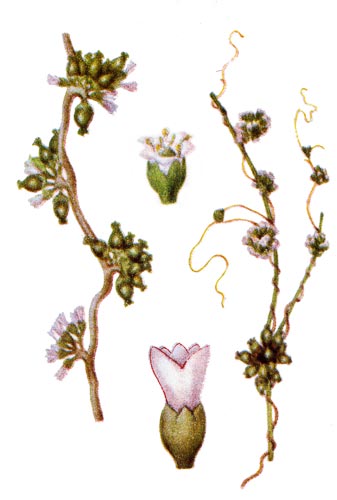Weeds
Cuscuta europaea L. - European Dodder
Systematic position.
Family Cuscutaceae, genus Cuscuta L.Biological group.
It is an annual stem parasitic plant.Morphology and biology.
Dodder has no normal roots and leaves. The stems of C. europaea entwine themselves around host-plants, attached by gaustoria. Stems are stout, up to 2.5 cm in diameter, red or reddish, branchy. Flowers pink or pinkish white, aggregated in spherical spreading inflorescences. Corolla is 2.5-3.5 mm long, pitcher-shaped. Calyx is 2-3 mm long, inversely conical. Fruit is a 4-seeded boll. Seeds are round or round-ovoid, 1-1.3 mm long. Flowering occurs in June-July.Distribution.
Distributed throughout the European part of the former USSR, Caucasus, West and East Siberia, Far East and Middle Asia. In Middle Asia and Caucasus, C. europaea grows in the zones of the middle and upper mountain belts.Ecology.
C. europaea prefers territories with abundant moisture. Immature seeds germinate faster than mature ones. It parasitizes wild-growing perennial plants (stinging-nettle, hop-plant), shrubs and young trees, most often on edges of forests, in bushes along banks of rivers, streams, springs, and also on rubble slopes of mountains. Dodder seeds are carried by wind, water, birds, mammals, and by man, during field work and especially during the transportation of seed material and agricultural products containing Dodder seeds. Spreading speed and harmfulness of the weed depends on density of infestation of affected crop.Economic significance.
Dodder causes a general breakdown of metabolism in cultural plants (sucking out organic and inorganic nourishing substances), weakens and detains the growth and development of host plants, leading to their death in mass. It parasitizes cultivated plants, settling among hemp, tobacco-plant, hop-plant, clover, lucerne, vetch, currant, gooseberry bushes and lilac. It is necessary to carefully separate the seeds of the main culture from the Dodder seeds, to destroy the Dodder along road sides, boundary-strips, waste lands during the entire vegetation period. Control measures against the Dodder include mechanical cleaning when it first appears on fruit-berry and decorative shrubs. Collected stems of the Dodder should be burnt. Control measures must be taken before flowering. Fields affected by Dodder must be sown for 3-4 years by unsusceptible cultures.Reference citations:
Beilin I.G. 1967. Control of dodders and broomrapes. Moscow: Kolos. 88 p. (In Russian)Budantsev A.L., Lesiovskaya E.E., eds. 2001. Wild-growing useful plants of Russia. Saint Petersburg: SPHFA. 663 p. (In Russian)
Butov A.Ya. 1958. Some regularity in distribution of species of the genus Cuscuta L. in Middle Asia. Works of V.I. Lenin Middle-Asian State University. Botany. Tashkent: SAGU. 57-61 p. (In Russian)
Fisyunov A.V., ed. 1984. Weed control reference book. Moscow: Kolos. 254 p. (In Russian)
Maltsev A.I. 1933. Weed vegetation in the USSR: A manual. 2 edition. Moscow: Kolhoz i sovkhoz literature. 296 p. (In Russian)
Nikitin V.V. 1983. Weeds in the flora of the USSR. Leningrad: Nauka. 454 p. (In Russian)
Pilyugin N. 1953. Dodder and its control. Yaroslavl: Kolhoz i sovkhoz literature. 19 p. (In Russian)
Shatalov T.A. 1987. Weed plants and their control in Rostov Region. Persianovka. 102 p. (In Russian)
Shishkin, B.K., ed. 1953. Flora of the USSR. V. 19. Moscow-Leningrad: AN SSSR. 752 p. (In Russian)
Shishkin, B.K., ed. 1965. Flora of the Leningrad Region. V. 4. Leningrad: LGU. 356 p. (In Russian)
Ulyanova T.N. 1998. Weeds in the flora of Russia and other CIS states. St. Petersburg: VIR. 344 p. (In Russian)


